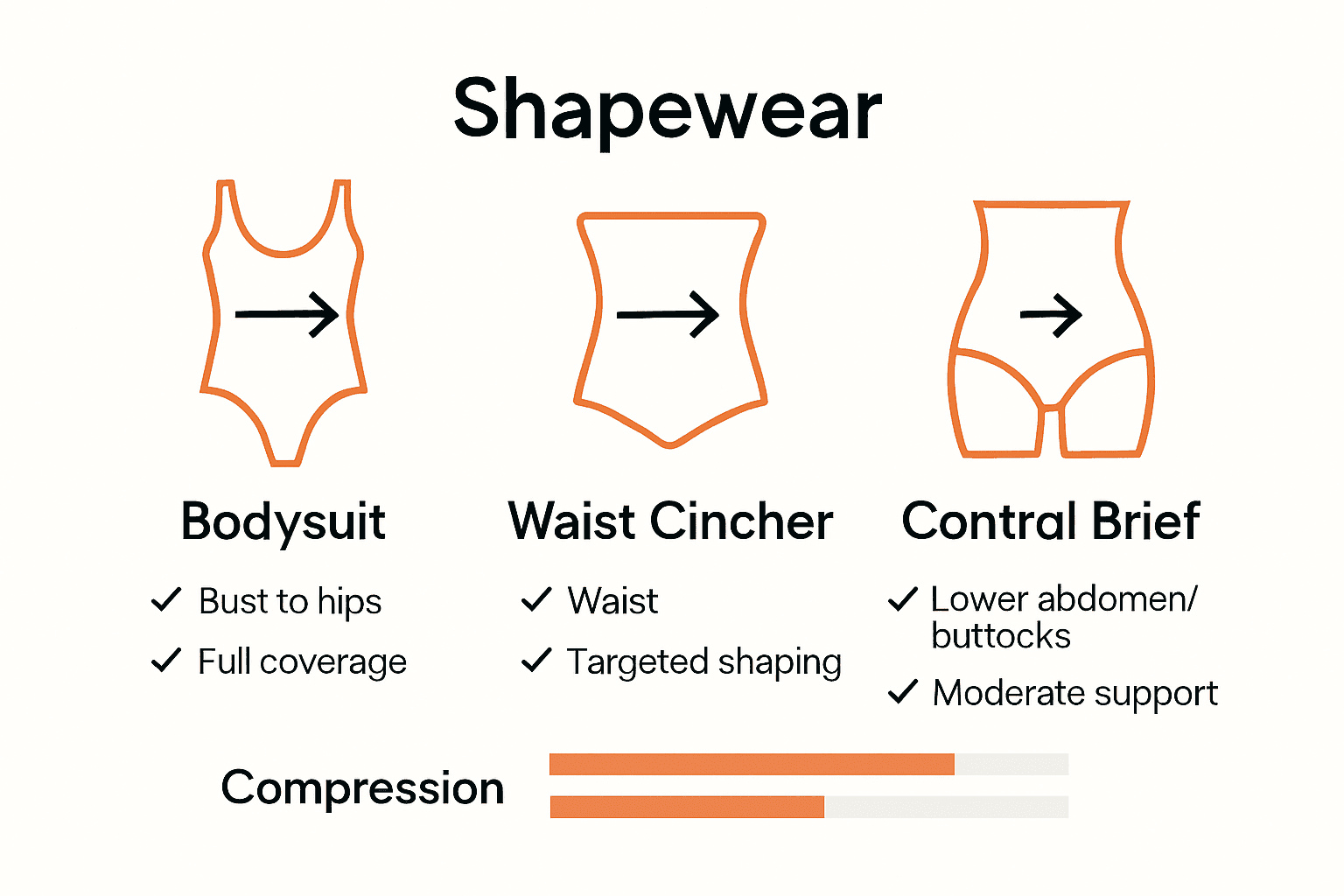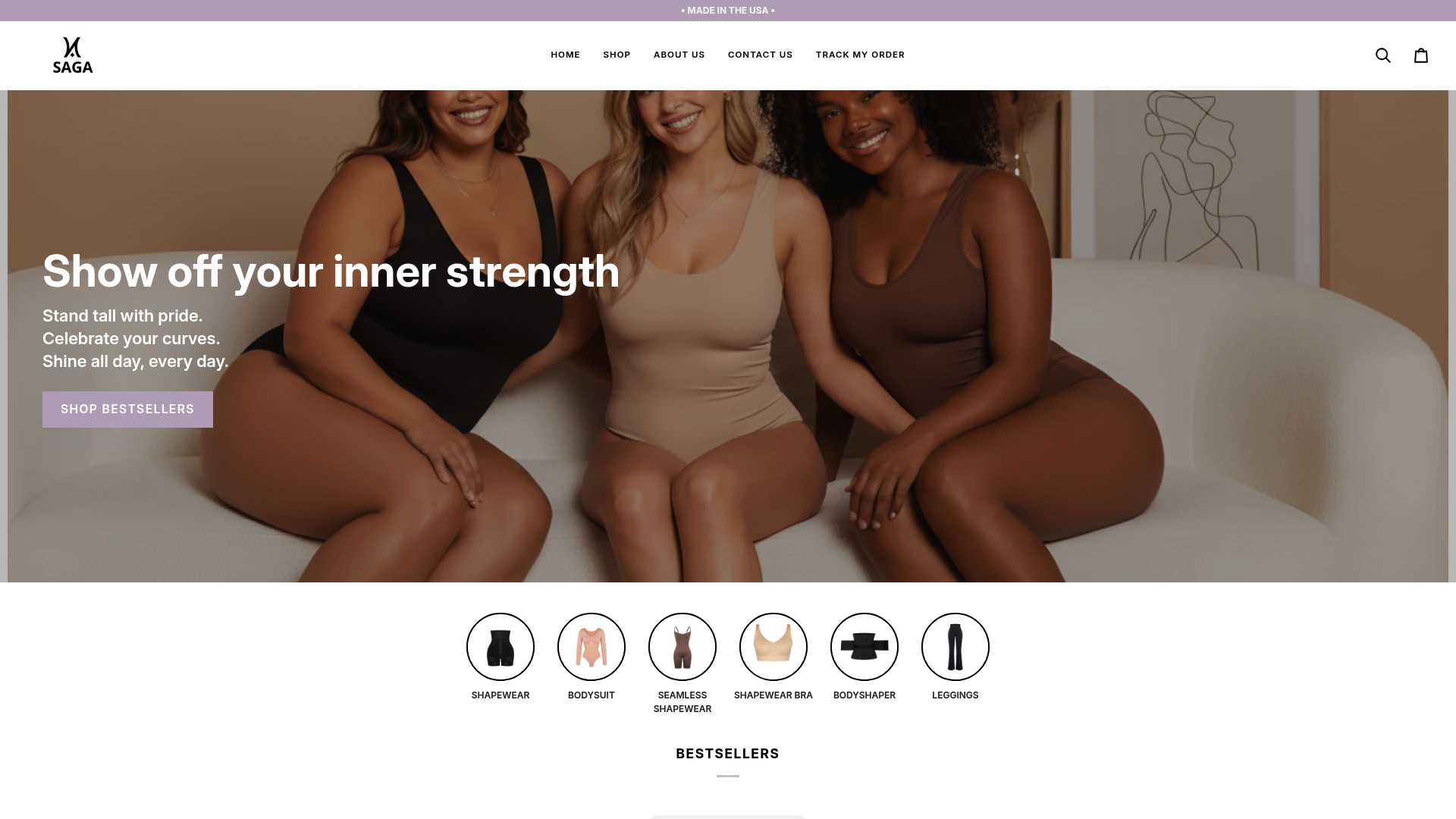Nearly 90 percent of women have tried shapewear at least once, searching for that extra boost of confidence under special outfits. The right shapewear can smooth lines, flatten curves, and help clothes fit more comfortably, all without surgery or extreme diets. If you’ve ever wondered how these contouring garments work behind the scenes, you’ll find practical answers here for choosing, using, and understanding what shapewear can really do for your body.
Table of Contents
- What Is Shapewear And How It Works
- Types Of Shapewear And Key Differences
- The Science Behind Shaping And Support
- Choosing The Right Fit For Your Body
- Common Concerns, Risks, And Safe Use
Key Takeaways
| Point | Details |
|---|---|
| Shapewear Definition | Shapewear is designed to temporarily enhance body contours through strategic compression, offering a smoother silhouette without permanent changes. |
| Selecting Shapewear | Choose shapewear based on body measurements, compression levels, and comfort to ensure a flattering fit and effective support. |
| Types of Shapewear | Different styles like bodysuits, waist cinchers, and control briefs target specific areas, each providing unique compression benefits. |
| Health Considerations | Prioritize comfort when using shapewear, avoiding overly tight garments to prevent issues like restricted breathing or digestive discomfort. |
What Is Shapewear And How It Works
Shapewear is a specialized type of undergarment designed to temporarily enhance body contours by strategically compressing and smoothing different areas of the body. According to sara.surgery, these garments can create a temporary improvement in silhouette, though they do not permanently reposition fat or tissue.
These body-hugging garments work through strategic compression and fabric technology. Key features include:
- Targeted Compression: Different sections apply varying levels of pressure to smooth and shape specific body zones
- Elastic Materials: Advanced fabrics like nylon and spandex provide flexible yet firm support
- Seamless Design: Minimizes visible lines under clothing for a sleek appearance
Shapewear essentially acts like a second skin, using controlled pressure to temporarily redistribute body volume. When you put on a shapewear piece, it gently compresses underlying tissues, creating a more streamlined profile. This means areas that might bulge or appear uneven can be subtly minimized, helping clothes fit more smoothly.
While shapewear offers immediate visual enhancement, it’s important to remember that results are temporary. Sara Surgery emphasizes that the moment you remove the garment, your body returns to its natural shape. For the most comfortable experience, choose shapewear that fits correctly - too tight can cause discomfort, while too loose won’t provide the desired shaping effect.
Types Of Shapewear And Key Differences
Shapewear comes in a diverse range of styles, each designed to target specific body areas and provide unique contouring benefits. Understanding the different types helps you choose the most effective garment for your body shape and clothing needs. From full-body solutions to targeted compression pieces, there’s a shapewear option for every silhouette.
Here are the primary Types of Shapewear:
- Bodysuits: Full-body coverage that smooths from bust to hips
- Waist Cinchers: Focused compression around the midsection
- High-Waisted Shorts: Smooths thighs and creates a streamlined lower body
- Compression Tanks: Targets upper body and provides torso smoothing
- Control Briefs: Offers concentrated shaping for the lower abdomen and buttocks
Each type of shapewear offers unique compression levels and coverage.
 Bodysuits provide the most comprehensive solution, essentially creating a smooth foundation underneath clothing. These garments are perfect for form-fitting dresses or when you want overall body smoothing. Saga Women’s shapewear collection guide highlights how different styles can address specific body contouring needs.
Bodysuits provide the most comprehensive solution, essentially creating a smooth foundation underneath clothing. These garments are perfect for form-fitting dresses or when you want overall body smoothing. Saga Women’s shapewear collection guide highlights how different styles can address specific body contouring needs.
Choosing the right shapewear depends on your outfit, body type, and comfort preferences. Lighter compression works well for everyday wear, while firmer options are ideal for special occasions. The key is finding a piece that feels comfortable and provides the desired smoothing effect without causing discomfort or restricting movement.
The Science Behind Shaping And Support
Body shaping technology represents a sophisticated approach to garment design that goes far beyond simple clothing. According to IOSR Journals, the fundamental aim of shapewear is to illustrate the perfect body shape to the outside world, with techniques evolving to meet diverse body shape preferences.
The science of shapewear relies on several key principles:
- Compression Mechanics: Strategic pressure distribution
- Elastic Material Engineering: Advanced fabric technologies
- Anatomical Mapping: Understanding body contour dynamics
- Tension Distribution: Balanced support across different body zones
At its core, shapewear works through biomechanical compression. The garments use carefully calculated tension points to redistribute body volume, creating smoother lines and more defined silhouettes. Specialized elastic materials like nylon and spandex blend together to provide flexible yet firm support, allowing the fabric to move with your body while maintaining its reshaping properties.

Understanding individual body mechanics is crucial in shapewear design. Different body types require nuanced compression strategies, which is why modern shapewear isn’t a one-size-fits-all solution. The most effective pieces are engineered to provide targeted support, adapting to individual body contours while maintaining comfort and maintaining natural movement.
Choosing The Right Fit For Your Body
Selecting the perfect shapewear is about more than just size - it’s about understanding your unique body shape, desired outcome, and comfort level. Finding the right fit requires careful consideration of your body’s natural contours, the clothing you’ll be wearing, and the specific areas you want to smooth or enhance.
Here are some key factors to consider when choosing shapewear:
- Body Measurements: Take accurate measurements of your waist, hips, and bust
- Compression Level: Determine how much control you want (light, medium, or firm)
- Clothing Type: Consider the outfit you’ll be wearing underneath
- Comfort Zone: Ensure the garment allows comfortable movement
- Fabric Breathability: Select materials that feel good against your skin
The most effective shapewear works with your body, not against it. Look for pieces that provide targeted compression without creating uncomfortable bulges or restricting your natural movement. Saga Women’s shapewear support guide recommends trying on multiple sizes and styles to find your perfect match. Pay attention to how the garment feels when sitting, standing, and moving - true comfort means you’ll barely notice you’re wearing shapewear.
Remember that sizing can vary between brands and styles. Don’t get discouraged if the first piece isn’t perfect. Some shapewear may require a size up or down from your regular clothing size to achieve the most flattering and comfortable fit. The goal is to feel confident and supported, not confined or uncomfortable.
Common Concerns, Risks, And Safe Use
Shapewear safety is a crucial consideration for anyone looking to enhance their body’s appearance. As Sara Surgery points out, while these garments can provide temporary silhouette improvements, they do not create permanent body changes.
Potential risks and concerns with shapewear include:
- Restricted Breathing: Overly tight garments can limit lung capacity
- Digestive Discomfort: Compression around the midsection may impact digestion
- Skin Irritation: Prolonged wear can cause chafing or skin sensitivity
- Circulation Challenges: Extremely tight shapewear might reduce blood flow
- Muscle Weakness: Constant compression could potentially weaken core muscles
To use shapewear safely, prioritize comfort and listen to your body. Choose pieces that allow natural movement and breathing, and avoid wearing them for extended periods. If you experience numbness, difficulty breathing, or persistent discomfort, remove the garment immediately. The most important rule is to select shapewear that feels like a second skin - supportive but not restrictive.
Remember that shapewear is a temporary solution designed to smooth and enhance your natural shape. It’s not a permanent body modification tool. Rotate different styles, take breaks between wearing, and always prioritize your physical comfort and health over achieving a momentary aesthetic effect.
Discover Confidence With the Perfect Shapewear Fit
Struggling to find shapewear that truly complements your unique body shape and provides all-day comfort while enhancing your silhouette? The challenge is real. You want that smooth, streamlined look without sacrificing comfort or natural movement. Our curated collection at Shapewear Bodyshaper – Saga Women offers targeted compression solutions designed to work with your anatomy, not against it. Experience the benefits of expertly engineered shapewear that redistributes body volume gently and effectively.

Take control of your look today by exploring styles that match your desired level of compression and outfit needs. Shop now at Saga Women and enjoy free US shipping and a 30-day easy return policy. Don’t wait to feel confident, supported, and comfortable in shapewear crafted just for you. Your perfect fit awaits at Seamless Shapewear – Saga Women.
Frequently Asked Questions
What is shapewear and how does it work?
Shapewear is a specialized undergarment designed to enhance body contours temporarily by compressing and smoothing specific areas of the body. It uses targeted compression, elastic materials, and seamless designs to create a streamlined profile while providing support.
What are the different types of shapewear available?
Shapewear comes in various types, including bodysuits, waist cinchers, high-waisted shorts, compression tanks, and control briefs, each designed to target specific body areas and provide unique shaping benefits.
How do I choose the right shapewear for my body?
To choose the right shapewear, consider your body measurements, desired compression level, the type of clothing you will wear it under, comfort preferences, and fabric breathability. Trying on different styles and sizes can help you find the best fit.
Are there any risks associated with wearing shapewear?
Yes, potential risks of wearing shapewear include restricted breathing, digestive discomfort, skin irritation, circulation challenges, and possible muscle weakness if worn excessively. It’s essential to prioritize comfort and not wear shapewear for extended periods.



